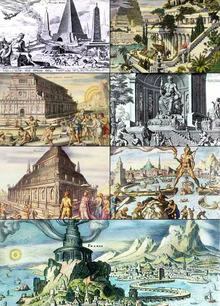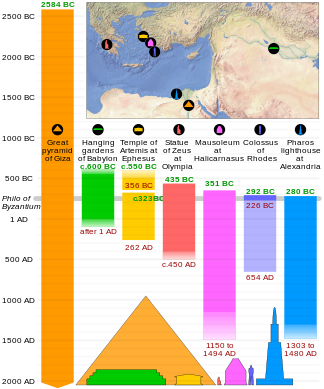Tujuh Keajaiban Dunia Purba
Tujuh Keajaiban Dunia Purba ialah senarai pembinaan klasik yang diberikan oleh pelbagai penulis dalam buku panduan atau puisi yang terkenal di kalangan pelancong Helenik purba.[1][2] Walaupun senarai itu, dalam bentuknya sekarang, tidak menstabilkan hingga Renaissance, senarai pertama tujuh keajaiban yang pertama kali dari abad ke-1 SM. Senarai asal mengilhamkan versi yang tidak terhitung sejak zaman, sering menyenaraikan tujuh kemasukan. Daripada Tujuh Keajaiban yang asal, hanya satu—Piramid Besar Giza (juga dikenali sebagai Piramid Khufu, selepas firaun yang membinanya), yang tertua dalam keajaiban kuno-tetap kekal utuh. Patung Raksasa Rhodes, Rumah Api Iskandariah, Makam di Halicarnassus, Kuil Artemis dan Patung Zeus semuanya musnah. Lokasi dan takdir terakhir Taman Tergantung tidak diketahui, dan ada spekulasi bahawa mereka mungkin tidak wujud sama sekali.[3][4][5][6]


Keajaiban sunting
Lihat juga sunting
Rujukan sunting
- ^ Diodorus Siculus. Bibliotheca Historica, Books I-V. 2.11.5: Perseus Project, Tufts University.CS1 maint: location (link)
- ^ Clayton, Peter A.; Price, Martin (2013-08-21). The Seven Wonders of the Ancient World (dalam bahasa Inggeris). Routledge. m/s. 158. ISBN 9781136748097. Dicapai pada 25 November 2016.
- ^ "History of the Past: World History".
- ^ Paul Lunde (May–June 1980). "The Seven Wonders". Saudi Aramco World. Diarkibkan daripada yang asal pada 2009-10-13. Dicapai pada 2009-09-12. Unknown parameter
|dead-url=ignored (bantuan) - ^ Clayton, Peter; Martin J. Price (1990). The Seven Wonders of the Ancient World. Routledge. m/s. 4. ISBN 978-0-415-05036-4.
- ^ Biographical Dictionary Volume III (dalam bahasa Inggeris). Society for the Diffusion of Useful Knowledge. 1843. m/s. 48. Dicapai pada 25 November 2016.
- ^ There is some conjecture as to whether the Hanging Gardens actually existed, or were purely legendary (see Finkel, Irving (1988) “The Hanging Gardens of Babylon,” In The Seven Wonders of the Ancient World, Edited by Peter Clayton and Martin Price, Routledge, New York, pp. 38 ff. ISBN 0-415-05036-7).
- ^ Kostof, Spiro (1985). A History of Architecture. Oxford: Oxford University Press. m/s. 9. ISBN 0-19-503473-2.
- ^ Gloag, John (1969) [1958]. Guide to Western Architecture (ed. Revised). The Hamlyn Publishing Group. m/s. 362.
Bacaan lanjut sunting
- Clayton, Peter A., and Martin Price. The Seven Wonders of the Ancient World. New York: Dorset, 1989.
- Deliyannis, Deborah Mauskopf. “The mausoleum of Theoderic and the Seven Wonders of the World.” Journal of Late Antiquity 3, no. 2 (2010): 365-85.
- D'Epiro, Peter, and Mary Desmond Pinkowish. What Are the Seven Wonders of the World? and 100 Other Great Cultural Lists. New York: Anchor Books/Doubleday, 1988.
- Jordan, Paul. The Seven Wonders of the Ancient World. Harlow, UK: Longman, 2002.
- Mueller, Artur. The seven wonders of the world: Five thousand years of culture and history in the ancient world. New York: McGraw-Hill, 1968.
- Romer, John, and Elizabeth Romer. The Seven Wonders of the World: A History of the Modern Imagination. 1st American ed. New York: Henry Holt, 1995.
Pautan luar sunting
| Wikimedia Commons mempunyai media berkaitan Tujuh Keajaiban Dunia Purba |
- How the Seven Wonders of the Ancient World Work: The Hanging Gardens of Babylon
- Plants in the Hanging Gardens of Babylon
- Artistic Renditions of the Hanging Gardens and the city of Babylon
- Animation of 3D virtual Hanging Gardens of Babylon
- The Lost Gardens of Babylon Documentary produced by the PBS Series Secrets of the Dead